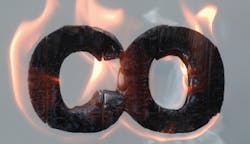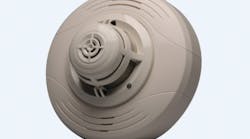Carbon Monoxide Detection
U.S. Municipal fire departments are responding to an estimated 72,000 non-fire, carbon monoxide (CO) incidents annually, and according to the NFPA, that trend that appears to be increasing year after year. Media reports of CO poisonings and deaths are also on the rise, thereby raising awareness of this threat to life safety.
Recent CO-related events, such as a Feb. 2014 incident at a New York restaurant that killed one person, have had a profound effect on local building requirements. In direct response to the New York incident, for example, the state enacted new, tougher legislation requiring every restaurant and commercial building to install carbon monoxide detectors (www.securityinfowatch.com/12038911). In fact, nearly 40 states have added new or more stringent CO detection mandates, applicable to a variety of buildings.
The risk, however, is certainly not limited to restaurants. Schools are one of the vertical markets hit hardest by carbon monoxide poisoning, and CO detection should be an important part of any security/safety plan for a school. A quick Google news search for school carbon monoxide incidents in the last 12 months revealed leaks and sickened students at an elementary school in Dallas; twice at a middle school in Cary, N.C.; a high school and an elementary in St. Louis; a high school in Blackwell, Okla.; a middle school in Girard, Ill.; and the list goes on. These and other incidents involving K-12 schools have driven a growing number of states to enact their own CO alarm mandates specific to educational facilities. Legislators in many states, such as New Jersey, are calling for stronger CO detection mandates that include K-12 schools.
The bottom line is if CO detection is not currently a requirement for specific occupancies within your region, industry trends hint that it soon will be.
Causes and Effects
Fire alarm dealers and integrators are viewed as life safety experts; therefore, it is important to understand what makes CO so dangerous. The CO molecule bonds with hemoglobin and reduces the oxygen-carrying capacity of blood in the body.
Often called the silent killer, carbon monoxide is an invisible, odorless, colorless gas created when fuels, such as gasoline, wood, coal, natural gas, propane, oil, and methane are burned incompletely. Some of the common sources of CO for commercial buildings are:
- Boilers, furnaces, hot water heaters or gas ranges that are not correctly installed or properly maintained (e.g. a furnace flue that is improperly sized, blocked or disconnected will result in dangerous levels of CO in the building);
- Gas power tools, portable generators and charcoal grills; and
- Exhaust from vehicles.
According to U.S. Centers for Disease Control and Prevention (CDC) studies, more than 400 people die every year in the U.S. from accidental carbon monoxide (CO) poisoning and over 20,000 individuals are injured due to CO poisoning each year. One of the most effective ways to reduce the incidence of CO poisoning is to ensure that CO detection devices are installed in places where people live, work, sleep, and study.
To reduce CO poisoning, newly constructed hotels, apartment buildings, dormitories, nursing homes and hospitals will be required to install CO detectors or CO alarms. The new 2012 International Fire Code (IFC) and International Building Code (IBC) requirements are consistent with the requirements in the 2009 edition of the International Residential Code (IRC) for CO detection to be installed in all newly constructed one- and two-family dwellings.
Technology
There are two industry standards covering CO alarm and detection devices. The first standard is ANSI/UL 2034, which covers single and multiple-station “alarms.” These devices are self-contained and are not intended to be connected to a control unit.
The second standard is ANSI/UL 2075, which is the standard for “detectors” that are designed and listed to be connected to a control unit — such as a commercial fire alarm panel listed as complying with ANSI/UL 864, or a household fire alarm panel listed as complying with ANSI/UL 985. Even though there are two product standards, they both have the same alarm thresholds.
It is important to remember that CO detection devices covered by these two product standards are intended to respond to the presence of carbon monoxide before a healthy adult loses their ability to react to the dangers of carbon monoxide exposure, such as calling 911 or exiting the occupancy.
Tips for Specifying Detectors
When facing a facility owner that must pay a substantial amount to update their building to include CO detection, there are a few favorable options you can recommend. A few manufacturers offer single devices that provide both fire and CO detection, which greatly reduces materials, labor and cost, while providing a cleaner aesthetic. Some manufacturers even offer online calculators to evaluate the financial benefit of such devices.
It is important to note that the device should be able to report both fire and CO alarms to the central station separately. For example, combo units like Silent Knight’s SK-Fire-CO detector (www.securityinfowatch.com/11248365) can be programmed to report an alarm or supervisory signal for fire events. NFPA 72, 2013 Edition, Sections 17.7.4.4 and 21.3.12 permit a detector to provide a supervisory signal for instances such as detectors in air ducts or plenums, as well as those detectors initiating elevator recall (where approved by the authority having jurisdiction).
Separate from the fire portion, the carbon monoxide element of a small number of combo detectors can be programmed for an alarm signal or supervisory signal. NFPA 72, 2013 Edition, Section 23.8.4.8 indicates that signals from carbon monoxide detectors shall initiate an alarm signal; however, there is an exception that allows carbon monoxide detectors to initiate a supervisory signal when in accordance with the building’s response plan, evacuation plan, fire safety plan or similar.
Whether a device is to initiate an alarm signal or a supervisory signal during a CO event is dependent on a few key pieces of criteria pertaining to the specific application. An analysis should be performed to determine what should be done with the signal, such as: Detector location; alerting of occupants; and appropriate actions required when a condition initiates.
As CO incidents rise and code adoption increases, being prepared is your path to success. Educate your customers on this silent killer and ways they can protect their facilities and occupants from harm. In addition, solutions to detect and alarm for CO should quickly become an everyday piece of a fire alarm dealer’s toolbox when discussing anything related to a commercial building’s fire alarm or other life safety systems.
Beth Welch is Communications Manager for Honeywell Fire Safety Americas. To request more info about the company, please visit www.securityinfowatch.com/12094950.
Online Exclusive Sidebar: Where to Place Detectors
Standards for placement of CO detectors within a facility are not as clear as those prescribed for smoke detectors. Section 9.4.1.1 of the 2012 edition of NFPA 720 requires CO detection to be installed outside of each separate sleeping area in the immediate vicinity of the bedrooms and on every occupiable level of a dwelling unit, including basements, but excluding attics and crawl spaces.
9.4.1.1* Carbon monoxide alarms or detectors shall be installed as follows:
- Outside of each separate dwelling unit sleeping area in the immediate vicinity of the bedrooms
- On every occupiable level of a dwelling unit, including basements, excluding attics and crawl spaces
- Other locations where required by applicable laws, codes, or standards
Since the molecular weight of CO is almost identical to air and it mixes quickly within a building, Section 9.4.1.2 permits each alarm or detector to be located on the wall, ceiling, or other location as specified in the manufacturer’s published instructions.
9.4.1.2 Each alarm or detector shall be located on the wall, ceiling, or other location as specified in the manufacturer’s published instructions that accompany the unit.
It’s important to point out that NFPA 720 requires the audible alarm notification signal to be at least 75dBA at the pillow in sleeping areas. If the detector is installed outside the sleeping area is unable to produce 75dBA at the pillow, with the door closed, a CO detector or a mini horn should be installed in the sleeping room.
For non sleeping locations in hotels, dormitories and apartment buildings, section 5.8.5.3.1 requires CO detectors to be installed on the ceiling in the same room as permanently installed fuel-burning appliances or centrally located on every habitable level and in every HVAC zone of the building
5.8.5.3.1 Carbon monoxide detectors shall be installed as specified in the manufacturer’s published instructions in accordance with 5.8.5.3.1(1) and 5.8.5.3.1(2), or 5.8.5.3.1(3):
- *On the ceiling in the same room as permanently installed fuel-burning appliances
- *Centrally located on every habitable level and in every HVAC zone of the building
- A performance-based design in accordance with 5.8.5.3.2
The reason NFPA 720 requires CO detectors to be located on the ceiling above permanently installed fuel-burning appliances is because of the buoyancy of the heated combustion gases as compared to normal ambient temperatures.



